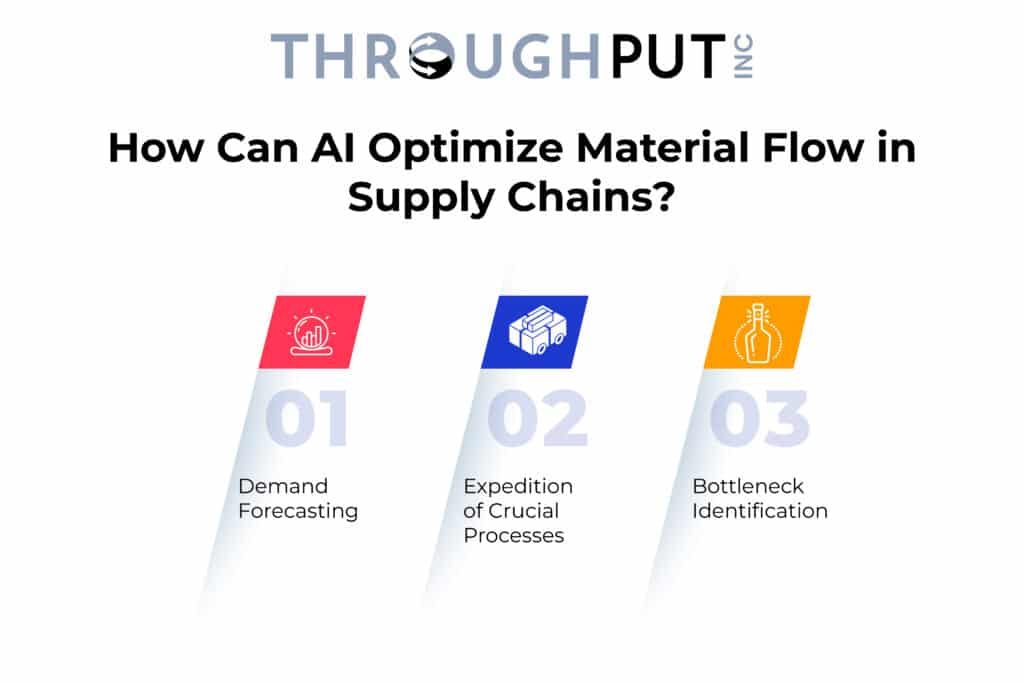Artificial Intelligence (AI) was the forerunner in the information revolution. The ultimate aim of AI was to come close to human-level intelligence.
But today, AI has surpassed human intelligence in many aspects. Organizations have come a long way from their initial reluctance in trusting AI systems to now depending on them for accurate insights.
Digitization with AI technologies and software suites is optimizing supply chain operations across the world for coordinated efficiency and resilience.
Supply chain material flow has become a global concern, unrestricted by limitations of geography. With supply chain complications such as constricted bottlenecks, complex material flows, and multi-tiered synchronizations, supply chain visibility has gained paramount importance.
With an organization’s operations spanning continents, it is imperative to upgrade and optimize supply chains for:
- Ease of Flow: Material goods need to flow across the supply chain with precision.
- Revenue Generation: If the cost of supply chain operations in a company is higher than the profits these operations are producing, the supply chain needs to be optimized to produce higher revenue.
- Recurring Profits: For supply chains to be self-sustaining, profits need to be recurring.
AI’s core competencies of error identification, delivering valuable insights, monitoring results in real-time, and using advanced computation to drive results make it a valuable asset for navigating material flow through the supply chain.
Leveraging AI to enhance supply chain material flow will provide a definitive guide to profitability.
Regulate Supply Chain Material Flow
The supply chain material flow is prone to errors at every stage. Supply chain material flow is monitored across the stages of Planning, Procuring, Producing, Delivering, and Returning. All of these key stages leave a lot of scope for glitches because of the unexpected interruptions in operations.
It is important to safeguard these processes and the communication channels across them to achieve a leak-proof material flow pipeline.
Reinforcing Supply Chain Visibility
Transparency and accountability go a long way in ensuring that no systematic errors take place in the supply chain. If plant managers get complete visibility of end-to-end material flow, it will ensure that-
- Problems are spotted and fixed as they emerge
High visibility ensures that the problems are fixed as they occur. Fixing them in the initial stages prevents a slowdown of the material flow. - Precarious junctures are smoothened out
With high visibility, it becomes easy to identify problematic material flow junctures. These junctures can then be analyzed thoroughly with AI-powered supply chain tools and smoothened out for ease of flow. - The inception of new processes
New processes can be created in the supply chain to solve problems of repeated delays or hold-ups. High visibility ensures that these pain points are identified and handled accordingly.
Enhanced Visibility Through Real-time Monitoring
Real-time monitoring through AI can further enhance the visibility and viability of supply chain material flow across the globe. Data procured through real-time metrics can drive up sales, bring down wastages and lead to a robust supply chain.
Real-time monitoring in supply chain
material flow refers to the moment-to-moment updates about demand, Stock Keeping Units (SKUs), Key Performance Indicator (KPIs), and stages of the supply chain. Real-time monitoring acts as a strong support system to other supply chain optimization processes, like:
Enhancing Agility
Agility in supply chain networks is a crucial business need today. Supply chain material flow needs to remain viable through all types of global upheaval, including natural disasters, shifts in geopolitical situations, and/or the next pandemic.
Agility in the material flow aids the procurement of raw material/services from different locations if one doesn’t work out. This procurement is only possible if real-time updates allow for this information to be made known instantaneously.
Quality Control
Quality control can be greatly enhanced if the material flow through the supply flow is monitored in real-time. Updates about poor quality units will appear in the manager’s dashboard as soon as low-quality goods appear either in the raw material handling stage or the production stage.
Cost Control
Cost control is a direct outcome of real-time monitoring in global supply chains. When material flow metrics are updated instantaneously, these updates help cut down on thousands of defective and unnecessary units being produced.
At the distribution stage, real-time metrics from users can inform distribution decisions, also cutting down wastages.
Efficient Material Flow Through AI-powered Supply Chains
Not only does digitalization add abundant resources to the supply chain material flow, but it also strengthens the processes of enhancing visibility and resilience.
The key strength of AI-powered software suites is to take in huge amounts of data, and derive relevant information from it. They also quicken the processes that would take humans years to master.
Software suites streamline material flow via demand forecasting, expedition of crucial processes, and bottleneck identification.

Demand Forecasting
Demand can be forecasted accurately through AI competencies. Having an accurate demand forecast ensures that supply is managed accordingly. Further, real-time changes in demands can be intimated to different stages in the supply chain, and production and distribution can be ensured accordingly.
Expedition of Crucial Processes
With AI, it is possible to identify crucial phases in the supply chain material flow. When AI technologies receive regular data about all of the processes involved, they process this data to find meaningful connections. These connections are vital in identifying the criticality of operations and the time it takes for execution. Over time, these processes can be optimized for a smoother flow of materials across the supply chain.
Bottleneck Identification
Bottlenecks can be easily identified and mitigated much before they can cause a hindrance to the supply chain material flow. For example, an error of a misdirected shipment can be fixed before the cargo leaves. This can cut down the costs of fixing these errors.
All of the critical channels in the supply chain material flow can be monitored and enhanced through AI. This enhancement greatly escalates the promptness and the visibility of a supply chain in all its aspects. End-to-end supply chain visibility can exaggerate bottom lines and lead to higher revenue generation.

AI-driven End-to-end Supply Chain Visibility
An essential component of supply chains in the modern world is end-to-end visibility. To facilitate the uninterrupted flow of both material and services, it is necessary to ensure that the supply chains remain agile and visible. AI pegs the holes in a close-ended, human-handled supply chain.
ThroughPut’s AI Solution facilitates agility and clarity through its features that identify and ease bottlenecks. With ThroughPut’s AI solution, deep-rooted visibility can be a key aspect of global supply chains ensuring higher efficiency at lower costs.
To see these results work for you, book a demo today.


